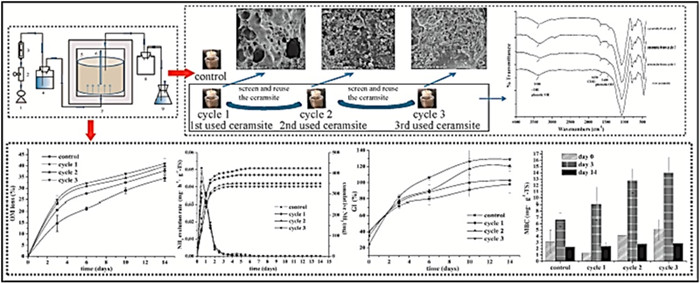Recycled Porous Ceramsite Becomes New Composting Material
Composting is an economical and environmentally friendly method for the disposing of organic solid wastes by which the waste could be degraded and converted into stable and mature compost with few readily degradable organic matter content and rich N, P, K nutrients, beneficial for the growth of crops.
However, the conventional composting method usually needs several months and even longer time to attain maturation and stability. Also lots of nitrogen nutrients are lost (mainly in the form of NH3) during the composting process, causing bad odors and serious reduction on the competitiveness in market.
To resolve the above problems, the Industrial Biogas Group led by Professor GUO Rongbo from Qingdao Institute of Bioenergy and Bioprocess Technology (QIBEBT), Chinese Academy of Sciences (CAS), proposed a method to accelerate the composting process and improve the compost quality by using the porous ceramsite as the bulking agent.
Ceramsite is a kind of porous material with high porosity and great specific surface area. As the bulking agent during composting, porous ceramsite could increase the pore structure of the composting pile which allows more oxygen to flow into the pile and therefore improves the microorganism activity.
In addition, ceramsite could reduce the nitrogen loss due to the acidic functional groups on the surface which have good adsorption ability to NH4+ and NH3. Compared with biochar which is the highly used porous bulking agent, ceramsite is much cheaper and recyclable resulting in great reduction of the composting cost. The paper has been published on Journal of Cleaner Production.
The results showed that the addition of porous ceramsite could accelerate the biodegradation of the organic waste and reduce the NH3 emission. Moreover, better effects were obtained with the increasing of ceramsite recycled times. Compared with the first used ceramsite, the organic matter loss increased from 37.8% to 41.0%, the reduction of cumulative NH3 increased from 8% to 21% and the germination index increased from 102.6% to 128.9% in group added with the third used ceramsite. Scanning electron microscope (SEM) image and Fourier Transform infrared spectroscopy (FTIR) spectra of ceramsite exhibited the microorganism and total acid functional groups increased significantly with the increasing of ceramsite recycled times.
This study provided a new bulking agent which is cheap and recyclable compared resulting in great reduction of the composting cost. Furtherly, the study revealed the mechanisms of enhanced composting process when amended with porous ceramsite which provide technical and theoretical support for further improvement of the composting art.
The project was supported by Shandong Provincial Key Laboratory of Energy Genetics (SDKLEG201807), the "Transformational Technologies for Clean Energy and Demonstration", Strategic Priority Research Program of the Chinese Academy of Sciences (XDA 21060400) and the Key Project of the Transfer and Transformation of Scientific and Technical Achievements, Chinese Academy of Sciences (KFJ-HGZX-009).

Fig: Effects of recyclable ceramsite as the porous bulking agent during the continuous thermophilic composting of dairy manure (Image by LI Xu)
(Text by LI Xu)
Contact :
CHENG Jing
Qingdao Institute of Bioenergy and Bioprocess Technology, Chinese Academy of Sciences
Tel: 86-532-80662647
E-mail: chengjing@qibebt.ac.cn